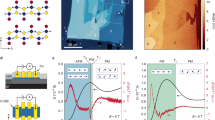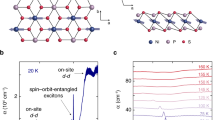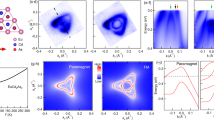Abstract
Electrical control over the magnetic states of doped semiconductor nanostructures could enable new spin-based information processing technologies. To this end, extensive research has recently been devoted to examination of carrier-mediated magnetic ordering effects in substrate-supported quantum dots at cryogenic temperatures, with carriers introduced transiently by photon absorption. The relatively weak interactions found between dopants and charge carriers have suggested that gated magnetism in quantum dots will be limited to cryogenic temperatures. Here, we report the observation of a large, reversible, room-temperature magnetic response to charge state in free-standing colloidal ZnO nanocrystals doped with Mn2+ ions. Injected electrons activate new ferromagnetic Mn2+–Mn2+ interactions that are strong enough to overcome antiferromagnetic coupling between nearest-neighbour dopants, making the full magnetic moments of all dopants observable. Analysis shows that this large effect occurs in spite of small pairwise electron–Mn2+ exchange energies, because of competing electron-mediated ferromagnetic interactions involving distant Mn2+ ions in the same nanocrystal.
This is a preview of subscription content, access via your institution
Access options
Subscribe to this journal
Receive 12 print issues and online access
$259.00 per year
only $21.58 per issue
Buy this article
- Purchase on Springer Link
- Instant access to full article PDF
Prices may be subject to local taxes which are calculated during checkout





Similar content being viewed by others
References
Zutic, I., Fabian, J. & Das Sarma, S. Spintronics: fundamentals and applications. Rev. Mod. Phys. 76, 323–410 (2004).
Wolf, S. A. et al. Spintronics: a spin-based electronics vision for the future. Science 294, 1488–1495 (2001).
Jonker, B. T. et al. Robust electrical spin injection into a semiconductor heterostructure. Phys. Rev. B 62, 8180–8183 (2000).
Ohno, Y. et al. Electrical spin injection in a ferromagnetic semiconductor heterostructure. Nature 402, 790–792 (1999).
Rüster, C. et al. Very large magnetoresistance in lateral ferromagnetic (Ga,Mn)As wires with nanoconstrictions. Phys. Rev. Lett. 91, 216602 (2003).
Abolfath, R. M., Petukhov, A. G. & Zutic, I. Piezomagnetic quantum dots. Phys. Rev. Lett. 101, 207202 (2008).
Fernández-Rossier, J. & Brey, L. Ferromagnetism mediated by few electrons in a semimagnetic quantum dot. Phys. Rev. Lett. 93, 117201 (2004).
Govorov, A. O. Voltage-tunable ferromagnetism in semimagnetic quantum dots with few particles: magnetic polarons and electrical capacitance. Phys. Rev. B 72, 075359 (2005).
Qu, F. & Hawrylak, P. Magnetic exchange interactions in quantum dots containing electrons and magnetic ions. Phys. Rev. Lett. 95, 217206 (2005).
Qu, F. & Hawrylak, P. Theory of electron mediated Mn–Mn interactions in quantum dots. Phys. Rev. Lett. 96, 157201 (2006).
Abolfath, R. M., Hawrylak, P. & Zutic, I. Electronic states of magnetic quantum dots. New J. Phys. 9, 353 (2007).
Léger, Y., Besombes, L., Fernandez-Rossier, J., Maingault, L. & Mariette, H. Electrical control of a single Mn atom in a quantum dot. Phys. Rev. Lett. 97, 107401 (2006).
Besombes, L., Léger, Y., Maingault, L. & Mariette, H. Spin properties of charged Mn-doped quantum dot. J. Appl. Phys. 101, 081713 (2007).
Seufert, J. et al. Dynamical spin response in semimagnetic quantum dots. Phys. Rev. Lett. 88, 027402 (2002).
Bacher, G. Optical spectroscopy on epitaxially grown II–VI single quantum dots (review). Top. Appl. Phys. 90, 147–185 (2003).
Maksimov, A. A. et al. Magnetic polarons in a single diluted magnetic semiconductor quantum dot. Phys. Rev. B 62, R7767–R7770 (2000).
Norberg, N. S. et al. Synthesis of colloidal Mn2+:ZnO quantum dots and high-TC ferromagnetic nanocrystalline thin films. J. Am. Chem. Soc. 126, 9387–9398 (2004).
Liu, W. K., Whitaker, K. M., Kittilstved, K. R. & Gamelin, D. R. Stable photogenerated carriers in magnetic semiconductor nanocrystals. J. Am. Chem. Soc. 128, 3910–3911 (2006).
Liu, W. K. et al. Room-temperature electron spin dynamics in free-standing ZnO quantum dots. Phys. Rev. Lett. 98, 186804 (2007).
Whitaker, K. M., Ochsenbein, S. T., Pollinger, V. Z. & Gamelin, D. R. Electron confinement effects in the EPR spectra of colloidal n-type ZnO quantum dots. J. Phys. Chem. C 112, 14331–14335 (2008).
Haase, M., Weller, H. & Henglein, A. Photochemistry and radiation chemistry of colloidal semiconductors. 23. Electron storage on ZnO particles and size quantization. J. Phys. Chem. 92, 482–487 (1988).
Shim, M. & Guyot-Sionnest, P. Organic-capped ZnO nanocrystals: synthesis and n-type character. J. Am. Chem. Soc. 123, 11651–11654 (2001).
Germeau, A. et al. Optical transitions in artificial few-electron atoms strongly confined inside ZnO nanocrystals. Phys. Rev. Lett. 90, 097401 (2003).
Furdyna, J. K. & Kossut, J. (eds) Diluted Magnetic Semiconductors (Academic Press, 1988).
Kolesnik, S . et al. Determination of antiferromagnetic interactions in Zn(Mn)O, Zn(Co)O and Zn(Mn)Te by inelastic neutron scattering. J. Appl. Phys. 99, 08M122 (2006).
Droubay, T. C. et al. Correlated substitution in paramagnetic Mn2+-doped ZnO epitaxial films. Phys. Rev. B 79, 155203 (2009).
Schwartz, D. A., Norberg, N. S., Nguyen, Q. P., Parker, J. M. & Gamelin, D. R. Magnetic quantum dots: synthesis, spectroscopy and magnetism of Co2+- and Ni2+-doped ZnO nanocrystals. J. Am. Chem. Soc. 125, 13205–13218 (2003).
Taft, K. L. et al. [Fe(OMe)2(O2CCH2Cl)]10, a molecular ferric wheel. J. Am. Chem. Soc. 116, 823–832 (1994).
Kahn, O. Molecular Magnetism (VCH, 1993).
Shapira, Y. et al. Nearest-neighbor exchange constant and Mn distribution in Zn1–xMnxTe from high-field magnetization step and low-field susceptibility. Phys. Rev. B 33, 356–365 (1986).
Andrearczyk, T. et al. Spin-related magnetoresistance of n-type ZnO:Al and Zn1–xMnxO:Al thin films. Phys. Rev. B 72, 121309 (2005).
Merkulov, I. A. et al. Kinetic exchange between the conduction band electrons and magnetic ions in quantum-confined structures. Phys. Rev. Lett. 83, 1431–1434 (1999).
Bussian, D. A. et al. Tunable magnetic exchange interactions in manganese-doped inverted core–shell ZnSe–CdSe nanocrystals. Nature Mater. 8, 35–40 (2009).
Myers, R. C., Poggio, M., Stern, N. P., Gossard, A. C. & Awschalom, D. D. Antiferromagnetic s–d exchange coupling in GaMnAs. Phys. Rev. Lett. 95, 017204 (2005).
Besombes, L. et al. Probing the spin state of a single magnetic ion in an individual quantum dot. Phys. Rev. Lett. 93, 207403 (2004).
Badaeva, E., Feng, Y., Gamelin, D. R. & Li, X. Investigation of pure and Co2+-doped ZnO quantum dot electronic structures using density functional theory: choosing the right functional. New J. Phys. 10, 055013 (2008).
Badaeva, E. et al. Theoretical characterization of electronic transitions in Co2+- and Mn2+-doped ZnO nanocrystals. J. Phys. Chem. C 113, 8710–8717 (2009).
Maingault, L., Besombes, L., Léger, Y., Bougerol, C. & Mariette, H. Inserting one single Mn ion into a quantum dot. Appl. Phys. Lett. 89, 193109 (2006).
Leger, Y., Besombes, L., Maingault, L., Ferrand, D. & Mariette, H. Geometrical effects on the optical properties of quantum dots doped with a single magnetic atom. Phys. Rev. Lett. 95, 047403 (2005).
Frisch, M. J. et al. Gaussian Development Version (Gaussian, Inc., 2007).
Kisi, E. H. & Elcombe, M. M. u Parameters for the wurtzite structure of ZnS and ZnO using powder neutron diffraction. Acta Cryst. C45, 1867–1870 (1989).
Borras-Almenar, J. J., Clemente-Juan, J. M., Coronado, E. & Tsukerblat, B. S. MAGPACK: A package to calculate the energy levels, bulk magnetic properties and inelastic neutron scattering spectra of high nuclearity spin clusters. J. Comput. Chem. 22, 985–991 (2001).
Acknowledgements
This work was supported by the US National Science Foundation (CHE 0628252-CRC to D.G. and X.L., DGE-0504573 (IGERT) to K.W.). Additional support from Gaussian Inc, the Research Corporation (Cottrell Scholar, D.G.), the Dreyfus Foundation (Teacher/Scholar, D.G.) and the University of Washington is gratefully acknowledged. E.B. thanks the Center for Nanotechnology at the University of Washington for UIF fellowship support. S.O. was supported by a fellowship for prospective researchers by the Swiss National Science Foundation (contract no. PBBE2-115064). EPR instrumentation support from the Center for Ecogenetics and Environmental Health UW Center grant no. P30 ES07033 from the National Institutes of Environmental Health Sciences, NIH, is gratefully acknowledged. TEM data were collected at Environmental Molecular Science Laboratory (PNNL), a national scientific user facility sponsored by the Department of Energy, and C. Wang (PNNL) is thanked for valuable assistance with this instrument.
Author information
Authors and Affiliations
Contributions
S.O., K.W. and W.L. performed the experiments. Y.F. and E.B. performed the DFT calculations. All authors discussed the experimental and computational results and analysis. S.O, Y.F., K.W., E.B., W.L., X.L. and D.G. co-wrote the paper.
Corresponding author
Rights and permissions
About this article
Cite this article
Ochsenbein, S., Feng, Y., Whitaker, K. et al. Charge-controlled magnetism in colloidal doped semiconductor nanocrystals. Nature Nanotech 4, 681–687 (2009). https://doi.org/10.1038/nnano.2009.221
Received:
Accepted:
Published:
Issue Date:
DOI: https://doi.org/10.1038/nnano.2009.221
This article is cited by
-
A Review of EPR and Magnetization Investigations of Doped Nanoparticles of Transition Metal Oxides and SiCN: Functional Materials and Spintronic Devices
Applied Magnetic Resonance (2024)
-
Quantum Spin Exchange Interactions to Accelerate the Redox Kinetics in Li–S Batteries
Nano-Micro Letters (2024)
-
Excitonic pathway to photoinduced magnetism in colloidal nanocrystals with nonmagnetic dopants
Nature Nanotechnology (2018)
-
Competing effects between intrinsic and extrinsic defects in pure and Mn-doped ZnO nanocrystals
Journal of Nanoparticle Research (2016)
-
A Review of EPR Studies on Magnetization of Nanoparticles of Dilute Magnetic Semiconductors Doped by Transition-Metal Ions
Applied Magnetic Resonance (2015)



